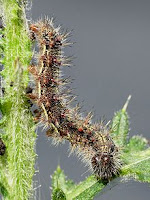
In some parts of the world they are referred to as Cosmopolitan butterflies for indeed they are. In our country there are three separate species but because I am on the East Coast, I can assume I am seeing Vannessa virginiensis. And may I say right here, that this butterfly has one of the simplest to say Latin names! In the genus Vannesa and the subgenus Cynthia.
Such ladylike names for these American Painted Ladies! Oh, and some people call the East Coast one simply, American Lady. You are free to pick your favorite.
At a quick glance, you might mistake it for a Monarch, because it too has orange and black in its wings, but it is almost half the size. A Monarch’s wingspan is between 3-4” where these “ladies” are usually 2”- and I love this for accuracy, to 2 7/8ths”. No rounding up apparently in the measurement of butterfly wings! I just can’t remember ever seeing so many, so I was interested to find out what their host plant is, to see if maybe I had planted something new last year, that the hungry larvae enjoyed. It turns out they, at least the East Coast species, is content with thistles and nettles which are easy enough to come by and the adults are happy to sip from anyone in the Composite family. Also an abundant group, including all the daisies, marigolds, clover etc. Not picky eaters and that bodes well for any animal.
I always think of the Mourning Cloak as being the only butterfly that over winters here but, according to what I read, the Ladies are the most tolerant of cold, making it through our winter as either adults or in the chrysalis stage. I’ll include pictures of larvae so you can know to hold back that squishing hand of yours if you see one. That is the trick isn’t it? People love to pick off and kill caterpillars, yet some of them will become such beautiful butterflies. And many folks love to plant butterfly gardens, but who is out there planting the larvae garden? You need both to get to the finished product. And with Google at your fingertips, why not research what the larvae looks like of those butterflies you want fluttering by your yard?

One other possible reason I saw so many, might be that almost every school group that came to the Nature center this week and saw American Ladies, claimed that they had raised that kind in class and let them go. Could it be then that the influx of so many lovely Ladies is thanks to some Earth day project? Perhaps. Whatever the reason, fluttering butterflies make any day seem dreamy and fanciful, don’t you think? But, fanciful or not, there are some realistic things that need to get done around here, so I shall be fluttering along. Again, so many topics we could cover, but so little time!

No comments:
Post a Comment